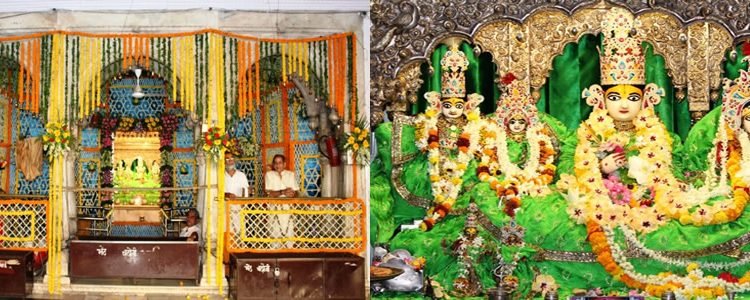Kanak Bhawan is the biggest, religiously one of the most important and architecturally an aesthetically built temple dedicated to Lord Ram and his divine consort Sita. It is located in the pilgrim holy town of Ayodhya in the state of Uttar Pradesh of India.
Shrine’s History
In the current Yug called the Kali Yug, it was first built by Chandra Gupta Vikramaditya in Yudisthir era 2431, repaired & renovated by Samudra Gupta in 387 A.D. (V.S. 444), destroyed by Nawab S. Salarjung II Gazi in 1027 A.D. (V.S. 1084) and then finally reconstructed on the ruins & renovated in the present shape by H.H. Maharaja Sri Pratap Singh Ju Deo, G.C.S.I., G.C.I.E. of Orchha and Tikamgarh (Bundelkhand) and his Queen Maharani Vrisbhan Kunwari, and consecrated in 1891 A.D. (V.S. 1948) Vaishkh Shukla 6th, Guru Pushya (roughly the month of May).
There are three pairs of consecrated idols?and all of them are those of Lord Ram and Sita. The largest pair is the one installed by Rani Sri Vrishbhan Kunwari who was the moving force in the construction and establishment of this temple. The pair to its right is of a medium height and is said to be those which were established by King Vikramaditya and were salvaged from destruction when that ancient temple was destroyed by invaders.
The third pair is the smallest and is traditionally believed be the one that was given by Lord Krishna to a woman hermit who was meditating on Lord Ram at this site. Krishna instructed her to bury the idols in the ground when she leaves her mortal coil (body) so that later on they would be discovered and act as a mark to identify the sacred place when a king would set out to resurrect this holy place during Kali Yug. It so happened by providence that when Vikramaditya was digging the foundation of his temple, this ancient pair emerged, and this helped this great king of India to locate the exact spot to establish the sanctum of his own grand temple.


Shrine’s Map Location and How to Go There
By Road
Ayodhya is 6 km (4 mi) from Faizabad. Ayodhya has good road connectivity with Lucknow (135 km), Varanasi (200 km), Allahabad (165 km) and Gorakhpur (175 km).
By Rail
The nearest railway station to Kanak Bhavan is Faizabad Jn Train Station which is 6 km away from Kanak Bhavan.
By Air
The nearest airport to Kanak Bhavan is the bareli airport , bareli which is 116 km away from Kanak Bhavan .
Shrine Timings
Timings for the opening of the temple and performance of worship: Open on all days of the year. (i) During Summer? Morning: 8 am-11.30 am. Evening: 4.30 pm-9.30 pm. Arti-8 am, 11.30 am, 7pm, 9.30pm. (ii) Winter: Morning: 9.00 am-12 pm, 4 pm-9 pm Arti-8.30 am 12 noon, 6.30 pm, 9 pm.<
Events Celebrated at This Shrine
Main Festivals: Though ceremonies and festivals keep on going throughout the year on various auspicious occasions according to the Hindu calendar, but some of them are special. All these occasions are marked by festivities and ceremonies as well as pomp and pageantry. Music and devotional songs reverberate in the temple. These special occasions are the following? (i) Ram Navmi marking the birthday of Lord Ram. It falls in the Hindu month of Chaitra which is roughly late March and early April. (ii) Janki Navmi marking the birthday of Sita. It falls exactly one month after Ram Navmi, i.e. in late April or early May. (iii) Phool Bangla?this is an occasion when the deity and the temple are decorated with flowers. It presents a fabulous sight. (iv) Jhula or the Swing Festival?it is organised during the onset of the rainy season roughly in August. A silver Swing is installed in the main hall of the temple and the deity is brought out from the sanctum to enjoy the Swing. The festival lasts for about fifteen days continuously. On the first day of this festival, the third pair of deities is taken out in a procession in the evening from the temple compound, winds its way through the streets of Ayodhya to reach a place called Mani Parvat. It is a place where the deities of all other temples of Ayodhya to assemble. After return to the temple premises, Darshan (viewing) of the deity is held on the silver Swing already installed in the hall. (v) Vijaya Dashmi?this is the Dusshera festival just prior to the well-known Indian cultural extravaganza and the festival of lights known as DiWali/Dipawali. It marks the victory of Lord Ram over the demon king Ravana. A special Darshan (view of the deity) is held in the outer hall of the temple. (vi) Sharad Purnima?this is the full moon night of Fall when it is believed that the Gods rain nectar on the earth from the heavens. On this occasion, a special Darshan (view of the deity) is organised in the open inner courtyard of the temple, directly under the beautiful light of the full moon shining overhead in the sky. (vii) Sita-Ram Vivaaha?this celebration marks the marriage of the divine couple Lord Ram and Sita. It is done in the traditional method when all the steps of the actual marriage ceremony are performed. A marriage procession is taken out in the evening from the temple premises, goes round the town, and comes back. The actual marriage rituals are done during the late evening hours on a stage erected in the main hall of the temple. Thousand witnesses this ceremony personally. This festival falls in late November or early December. (viii) Gauna?this is the time when the wife left her parental home for the home of her in-laws and husband. It is celebrated about a fortnight from the marriage festival. (ix) Holi?this is the fabled festival of colours in India. A Darshan of the deity is organised in the main hall of the temple, and devotees offer dry coloured powder to their Lord.













































